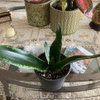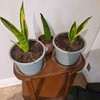trifasciata vs.laurentii :an unorthodox point of view.
Trifasciata vs.laurentii : an unorthodox point of view.
Part I. S.trifasciata Prain
Some weeks ago, in a post devoted to identify a plant of ‘Bantel’s Sensation’, Stush suddenly asked (to himself, I suppose): “So, laurentii is not a trifasciata?”. Everybody agreeds that ‘Laurentii’ “... is actually a variegated cultivar that first appeared in a garden...and is not a genuine botanical variety.” (quote from S.Jankalski, Hort.net, 21/08/1999). So, the matter is clear : S.trifasciata is a botanical species and ‘Laurentii’ is a cultivated variety originated from this species.
So what? Well, on my opinion, the correct answer to Stush’s question is : “Yes, ‘Laurentii’ is a true species while trifasciata is a still undefined entity!”
This sounds as an awkward assumption, and I am here, willing to explain myself.
Let’s go back to the year 1903 and travel to the far and mysterious region of Bengal (the South Eastern part of the British Indian Empire , now split between India and Bangladesh). That year Sir David Prain, Superintendent of The Botanical Survey of India and Director of the Calcutta Botanic Garden, published a checklist of all the “Bengal Plants” (this is the title of his two volumes work) known at his time. On page 1053 (Vol.II) he comes to the Genus Sansevieria Thunb. , listing three only species: roxburghiana, cylindrica and trifasciata. While the first two species had already been described and were well known at the time, S.trifasciata hort. was a newcomer. The name is preceded by this concise (to say the least!) description: “Leaves rather wide ensiform, flat, not channelled above; flowers about an inch long”. That’s all.
Do these words remind You a flowering plant of S.trifasciata ?
Is this an adequate ‘scientific description’ (or “protologue” in a more botanically speaking...) that clearly identifies an unknown species?
Did Sir Prain collect any specimen plant to be presented “in vivo” or dried in an herbarium to the scientific world?
Sorry, but the three answers are three round “No!”
Sir Prain then adds this short comment: “Often cultivated; sometimes as an escape. A herb, with tufted, linear lanceolate leaves. Closely related to W. African Bowstring Hemp (S.guineensis), but with narrower, more definitely maculated leaves.” This makes sense for the use of the old term “hort.” (hortulanorum, the latin word for ‘of the gardeners’) following the species name, meaning the plant is not growing in its habitat, but comes from a garden (it is in fact an African plant!). In a later work (Contrib. To Indian Botany , pag. 339, 1906) he amends: ”...probably native of West Africa, but appears to have reached India from America...” a long travel indeed! Sir Prain doesn’t explain why he chose the adjective “trifasciata” (three banded), and this is still a big question mark.
So, nothing in Prain’s description is worth considering, in order to describe a new plant species.
Nevertheless, N.E.Brown, in his biblical Monograph of the Genus Sansevieria (1915, pag.239), boldly accepts Prain’s description : why? Well, consider Brown was working as an employee at the Kew Gardens and, guess who was the Director at the time? Poor Brown can’t help but suggest “...this species has been in cultivation for over 150 years...”. Is it possible no one realized for one century and a half that this most common plant was a new species?
Let’s travel even more back in time and pay a visit to the splendid Botanic Garden in the Imperial Schonbronn Palace in Wien. It is the year 1770 and the famous botanist, the honourable Baron Nikolaus Joseph Freiherr von Jacquin is puzzled with a plant in his collection: he had received it named “Aletris guineensis”. He realizes the label has to be rewritten, because, as he explains on page 36 of his “Hortus Botanicus Vindobonensis”: “...as soon as I saw its many, ripe fruits, clearly showing their anatomy, I believed... this plant couldn’t belong to Aletris nor to Aloe, nor to any other known genus.” A latin description follows. Turning the page You will have the pleasure to see a masterpiece of botanical art, possibly one of the most accurate portrait of (what we have, up to now, known as) S.trifasciata. The hand coloured plate (T.84) shows in fine detail a leaf, rhizome, inflorescence with many flowers, and a fruit. In the absence of any earlier herbarium material, no one will doubt this illustration is to be taken as the “type” (iconotype) of the species. Many years ago I had in my hands one of the few existing copies of this volume, guarded in the Biblioteca Nazionale di Firenze. Despite being badly damaged by the terrible flood of 1966, it is valued about 50,000 dollars...
Freiherr von Jacquin, didn’t resolve to make the following step, that is creating a new genus for his old plant. It was Father Antonio Jose Cavanilles (director of the Real Jardin Botànico de Madrid) who took over the job, and described the new plant as “Salmia guineensis Cavanilles” (Icones et Descript. Plantarum..., Vol.III, pag.24, 1794). Both these (more than two century old!) descriptions are scientifically impeccable, but Brown threw them among the endless list of synonyms, inextricably mixed with the “true” S.guineensis (now S.hyacinthoides(L.)Druce).
And here is the problem: Jacquin and Cavanilles repeated the specific adjective “guineensis”, which Linnaeus himself used for his Aloe hyacinthoides v. (beta) guineensis (Species Plantarum, 1753, pag.321). We actually know this is a different species: S.hyacinthoides (L.) Druce. Oddly enough, no one, for as long as one century, realized that Jacquin’s plant was something else. And, when we go back for the man who first described this plant with a different, unambiguous, specific name...well, we find none!
So, isn’t it time to think of a new name for an old plant ?









bonsaigai
roberto2Original Author
Related Professionals
Rancho Cordova Landscape Architects & Landscape Designers · Saint Louis Park Landscape Architects & Landscape Designers · Salisbury Landscape Architects & Landscape Designers · Sand Springs Landscape Architects & Landscape Designers · Taylorsville Landscape Architects & Landscape Designers · Norwood Landscape Contractors · Mission Bend Landscape Contractors · Morrisville Landscape Contractors · New Providence Landscape Contractors · Santa Ana Landscape Contractors · Soddy Daisy Landscape Contractors · West Coon Rapids Landscape Contractors · Crestwood Window Contractors · Decatur Window Contractors · West Springfield Window Contractors